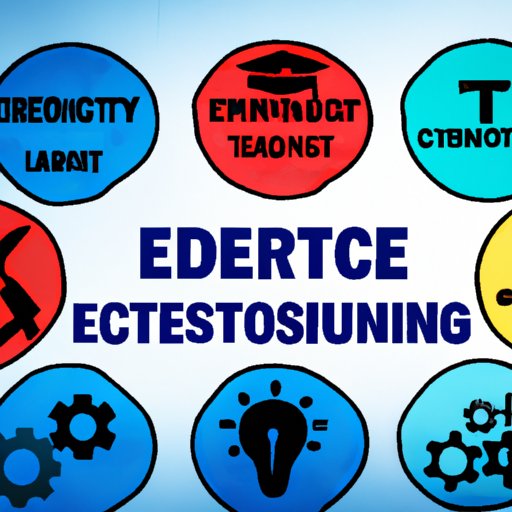
Introduction
Career and Technical Education (CTE) has gained significant traction in recent years as an alternative education pathway for students seeking a career-oriented curriculum. CTE is designed to prepare students with the skills needed to enter the workforce directly or continue further education on a career path. This article offers a comprehensive guide to CTE education, discussing the benefits, challenges, and strategies of CTE programs.
The ultimate guide to understanding CTE in education
What is CTE?
CTE stands for Career and Technical Education, which focuses on providing students with the academic and technical skills required to pursue specific careers. CTE combines rigorous academic coursework with hands-on learning experiences in various fields, including business, health, technology, and STEM.
Brief history of CTE
The origins of CTE can be traced back to the early 1900s when schools began offering vocational education programs. However, the current form of CTE education began in the 1980s as a response to the changing economy and the need for a more skilled workforce. The passage of the Carl D. Perkins Vocational and Applied Technology Education Act in 1984 marked a significant milestone in the growth and development of CTE education in the United States.
Types of CTE programs
CTE programs include a variety of career pathways, including agriculture, business management, culinary arts, engineering, finance, health sciences, information technology, and many others. These programs offer students the opportunity to acquire certificates, diplomas, or associate degrees.
Popular CTE fields
According to recent data, some of the most popular CTE fields include health services, information technology, business management, manufacturing, and construction. These fields not only offer high-demand job opportunities but also have a positive impact on the economy.
CTE: What it means and why it’s important in today’s education system
Importance of CTE education in today’s economy
CTE education plays a critical role in the country’s economic growth and development. According to recent statistics, about 30% of all jobs in the US require some level of technical education or training beyond high school. By providing students with the skills necessary to enter the workforce directly, CTE programs contribute to creating a more skilled workforce and reducing the skills gap.
Benefits of CTE education for students, educators, and employers
CTE education benefits not only the students but also the educators and employers. Students who participate in CTE programs are more likely to graduate high school, enroll in postsecondary education, and become gainfully employed in high-demand occupations. Educators benefit from CTE programs by having opportunities for professional development, teaching innovative curriculums, and being part of a growing industry. Employers benefit from CTE programs by having access to highly-skilled workers, reducing recruitment costs, and filling critical skill gaps in various industries.
How CTE education promotes career and technical skills
CTE education emphasizes problem-solving, critical thinking, and technical skills. Students in CTE programs learn job-specific skills through hands-on classroom experiences, internships, and apprenticeships with industry professionals. These experiences prepare students for the expectations of the workforce, allowing them to enter the job market more competently and confidently.
How CTE programs are shaping the future of education and workforce readiness
Importance of CTE programs in shaping the future
CTE programs are leading the way in shaping the future of education and workforce readiness. These programs teach technologically advanced skills, preparing students for jobs and industries that don’t exist yet. By shaping a more versatile and skilled workforce, CTE programs are also making way for America’s economic progress by creating jobs, improving industries, and fostering innovation.
Skills and knowledge acquired from CTE programs
CTE programs foster technical, creative, problem-solving, and critical thinking skills. Students learn actual job skills, which allows them to join the workforce and contribute immediately. The knowledge acquired is rooted in real-world experience obtained through internships, apprenticeships, and other real-world opportunities. With skilled mentors passing along their knowledge, qualified in-demand workers can be produced faster and more efficiently.
Success rates of students enrolled in CTE programs
Research consistently shows that CTE students have lower dropout rates, higher participation in postsecondary education, and greater success in the workplace than non-CTE students. More than 90% of high school students who take CTE courses graduate from high school, compared to the national average of 84%. Additionally, CTE students are more likely to participate in meaningful internships or apprenticeships, obtain employment within six months of graduation, and see higher earnings over their lifetime.

Exploring the benefits and challenges of implementing CTE in schools
Advantages of implementing CTE in schools
CTE programs create opportunities for students to explore their interests and passions while cultivating technical knowledge, skills, and abilities that cut through time efficiently. These programs help students find avenues to attain well-paying jobs while supplying ever-changing and in-demand industries with a highly skilled workforce. Schools reap the benefit of being conduits of industry- and education-driven thinkers. Employers benefit from having a large pool of candidates to choose from.
Challenges facing CTE education programs
There are challenges to implementing CTE programs such as funding, curriculum development, teacher training, and program evaluation. With pressure on schools to allocate federal or state funds in academically rigorous programs (and the perception that CTE programs are inferior), CTE programs often struggle for proper funding. Additionally, creating innovative curriculums, teacher training, and program evaluation require significant investment, resources, and support to initiate and operate.
How to overcome the barriers of implementing CTE programs
To overcome the barriers of implementing CTE programs, it will require investment, resources, and support. Teachers and administrators must work collaboratively to share their expertise and create workgroup discussions engaging policy-makers, industry professionals, and community stakeholders.
CTE success stories: Spotlighting students who have excelled in CTE programs
Examples of successful CTE students
The success of CTE programs can be measured by the exceptional stories of CTE graduates. For instance, thousands of students have been placed in high-paying jobs that they regard fulfilling and rewarding. Some have even started their own businesses. Among the notable success stories of CTE education is Lenny Williams, who took a culinary arts program in high school and later went on to attain a bachelor’s degree. After graduation, he started his restaurant business.
Benefits of CTE programs for students
CTE programs offer numerous benefits to students. Students learn invaluable job skills, gain real-world work experience and they are better equipped and prepared for college or other further educational opportunities if they decide to attend. Additionally, CTE programs offer an extensive range of opportunities to explore a diversity of topics and put students ahead of the game in an ever-changing economy.
How CTE programs have helped students succeed in their future careers
CTE education has been instrumental in the success of former students. It gives them the technical and practical skills and abilities needed to excel in their future careers. The hands-on work with skilled mentors provides an opportunity to learn from those with real-world workplace experience while simultaneously carrying out practical instructions upon which the workforce is designed. This results in more confident and independent students that can excel in their future careers.
Promoting equity and diversity in CTE programs: Strategies for success
Importance of promoting equity and diversity in CTE programs
Access and opportunities to quality CTE programs must be guaranteed for all students, regardless of their background, to provide diverse pathways for students who seek non-traditional paths in the labor market. It is essential to promote equity and diversity in CTE programs to address the gender, racial and ethnic disparities present in the labor market today.
Challenges facing CTE programs related to equity and diversity
Equity and diversity in CTE programs are still evolving issues. Gender, racial, and ethnic disparities exist within CTE due to specific entry barriers and lack of diversity in educators and industry professionals. Additionally, stereotypes about CTE programs often deter students from enrolling in them.
Strategies for promoting equity and diversity in CTE programs
Promoting equity and diversity in CTE programs requires creating accessible programs with high-quality instruction with diverse and inclusive advertising to pique the interest of the diverse population. Encouraging more women and underrepresented minorities to become involved with CTE programs, improving the diversity of educators, and incorporating bias-free curriculum throughout all instructional materials are all critical steps toward fostering equity and diversity within CTE education.
The role of technology in advancing CTE education for the future
Importance of technology in CTE education
The role of technology in CTE education is critical in promoting a futuristically skilled workforce that can keep up with the latest advancements. Technology provides an opportunity for CTE students to develop, experiment with, and deploy software for a wide range of purposes. An expected increase in automation means new opportunities in CTE training and training on industry-level software as any skilled workforce must know how to use the latest tech.
Benefits of incorporating technology in CTE programs
Incorporating technology into CTE education offers numerous benefits to students. For instance, it offers increased versatility in curriculum development, improved student engagement, and up-to-date interactive learning opportunities. Additionally, Industry-driven tech knowledge provides students in CTE programs with real-world experience and a marketable skillset that will benefit them throughout their future careers.
Examples of technology used in CTE programs
Among the technologies used in CTE programs are 3D printing and modeling software, CAD design, coding technologies, augmented and virtual reality, diversity and inclusion software, and robotics technologies. These technologies offer students the ability to learn and experiment with high-quality tools, ready for deployment in a professional environment with hands-on training and experience as they progress through their coursework.
Conclusion
Recap of the article
Career and Technical Education (CTE) programs offer students the opportunity to acquire knowledge, technical and practical skills, and abilities required to excel in high-demand industries. CTE programs play a vital role in shaping the future of education and workforce readiness, and it’s crucial to promote equity and diversity within these programs. Incorporating technology into CTE programs also advances and equips students better for the demands of the fields.
Call to action for readers to support CTE education
CTE education is critical to our economy’s success, addressing the deficit of technical and labor skills. All stakeholders should support CTE programs and work together to address the challenges and opportunities of fostering innovative curriculums rigorously. Support for equality and diversity should remain a crucial concern in hiring, promoting, and promoting Student’s equal access to quality CTE programs at every level.
Final thoughts on the importance of CTE education
CTE education offers students unique opportunities to hone their practical and technical skills, preparing them for a successful future in the labor market. It is imperative that all students have access to quality CTE programs, promoting equity and diversity in these highly valued programs that are an integral part of our economy.





